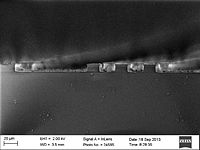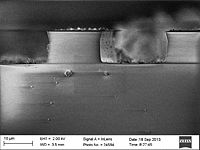Specific Process Knowledge/Etch/Etching of Bulk Glass/AOE etching of fused silica
Feedback to this page: click here
Comparison of masking materials and AOE processes etching fused silica
| AZ resist mask | PolySi mask | Cr mask | |
|---|---|---|---|
| Generel description | Using a photoresist mask as etching mask is often convenient, since it takes less process steps to make than hard masks. The draw backs using resist as masking material in the AOE on glass is that glass does not transfer heat well and therefore the He cooling in the AOE does not work well on glass substrates. This makes the photoresist turn very hot during the etch and that might burn the resist. Resist also has low selectivity to glass so deep glass etch is not working well with photoresist as masking material. | Using Poly Silicon as masking material in the AOE has the advantage over photoresist in the fact that the mask can stand a higher temperature. Then a recipe with higher etch can be used. It also as a higher selectivity so it is possible to etch deeper.The draw back might be higher line width reduction but this has not been expored yet. | This recipe with a Cr mask gives the highest etch rate, but the wafer uniformity is not so good. |
| Substrate |
|
|
|
| Mask material/thickness |
|
|
Pattern defined in the ICP metal |
| Coil Power |
|
|
|
| Platen Power |
|
|
|
| Platen temperature |
|
|
|
| He flow |
|
|
|
| C4F8 flow |
|
|
|
| O2 flow |
|
|
|
| H2 flow |
|
|
|
| Pressure |
|
|
|
| Etch rate in fused silica |
Reduced etch rate in long etch might be due to either resist gone at the end, substrate being very hot=>larger polymerization during etch. The polymer/resist left on the wafer after etch was less than 20nm and it looked burned. ± refers to the variation over the wafer. |
± refers to the variation over the wafer. |
|
| Selectivity to mask |
|
|
|
| Linewidth reduction |
|
|
|
| Substrate size tried |
|
|
|
| Images |
|


